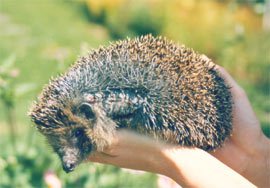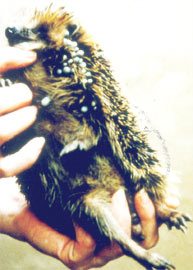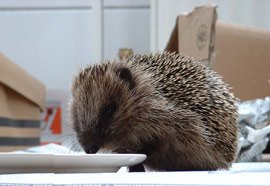
Nearly all the hedgehogs taken into human care – apart from most orphaned hoglets – are sick. Even so-called “Autumn Orphans” are hardly ever “just” underweight, but are suffering from severe infestations of internal and/or external parasites.
Make sure you observe basic hygiene rules when dealing with hedgehogs! Wash your hands thoroughly after handling every hedgehog!
Basically, treatment of any sick hedgehog will only be successful once it has regained its normal body temperature (approx. 36°C)
We refer veterinary surgeons and experienced hedgehog carers to our (German) booklet The hedgehog in the vet’s practice which was written for veterinary surgeons by a vet who is herself extremely experienced with hedgehogs. This German specialist publication is revised with every new edition.
As a diagnostic and therapeutic aid we recommend the CD-ROM Parasitoses and mycoses of the hedgehog.
You can order our publications with the Online order form.
As a general principle, hedgehogs should be housed individually. Only litter-mates should be put together at the beginning (until they reach 250-300g bodyweight). Keeping hedgehogs on their own is a basic requirement for restoring them to health and avoids the risk of cross infection, in addition, it corresponds with the biology of the solitary hedgehog. Read more about this on the page about the Housing of hedgehogs in care.
If you find a hedgehog you should examine him carefully for injuries. To do this you must inspect the head, belly and legs. If the hedgehog is injured you should take the prickly patient to a vet at once. The treatment of injured hedgehogs is a matter for a vet who is familiar with them and/or an experienced hedgehog rescue centre.
In the summer months, you will find fly eggs and maggots in wounds, and also in the body orifices (ears, mouth, anus etc) of uninjured but sick and weak animals. These must be removed immediately. Fly eggs are whitish and rodshaped, about 1.5 mm long and clumped together, maggots are like little white worms. Remove them very carefully with tweezers.
Hedgehog fleas are best removed with a special spray- available from a pet shop or vet. For young/weak hedgehogs only choose a gentle product which will not adversely affect the patient. Don’t use flea powder! It sticks inbetween the spines and on the feet and could get walked into food and ingested.
Ticks should not be treated with oil, nail varnish or glue! Grip them with tweezers as close to the hedgehog’s skin as possible and pull them off with a twist.
Hedgehog patients should only be bathed when absolutely necessary, as this procedure will cause even more stress in addition to their weakness and captivity.
Hedgehog rescue centres and vets will help with the removal of parasites.
If a hedgehog has no external injuries, then internal parasites are the probable cause of his weakness and emaciation. Internal parasites include lung threadworm, lungworm, intestinal threadworm, intestinal fluke and also coccidia and tapeworm. A light to moderate internal parasite burden is normal in wild animals; however, a heavy infestation linked with lack of food or debilitation after rearing young, can be lethal. Lack of appetite, coughing or noisy breathing are symptoms of heavy lungworm infestation.
Therefore, most hedgehogs taken into care are treated for internal parasites.
Note: The active ingredient Doramectin (German trade name Dectomax), is effective for worming domestic and farm animals, but is only effective against the lungworm Crenosoma str. in hedgehogs, however, it works demonstrably slower than the active ingredient Levamisole (German trade names Levamisol 10%, Belamisol 10%, Nematovet 10%) because this has the beneficial side effect of stimulating the appetite of the majority of emaciated and weak animals, thus facilitating the hedgehogs’ recovery. – (See “Igel in der Tierarztpraxis” and “Krankheiten der Heimtiere” 7th, total revised edition 2008.)
A faecal examination will tell you what parasites the animal is suffering from. Collect the droppings over several days, soft or runny bits are best – and take them to be examined by a parasitological institute, vet or adequately equipped hedgehog rescue centre. Then the hedgehog can be prescribed the correct treatment!
Scabby lesions on the skin or significant spine loss are signs for skin diseases. Those can have different causes. Mites or ringworm can be the reason for spine loss and skin changes. As the person finding the hedgehog cannot possibly know the cause for this, hygiene is of the highest order when handling the patient. Some skin diseases (mycoses) are zoonotic (transmissable to humans) – therefore the carer must wear spine-proof gloves at all times when handling the hedgehog. Diagnosis and treatment are matters for a vet who is used to dealing with hedgehogs. Vets who are well versed in treating hedgehogs often work in co-operation with a rescue centre.
Frequently, bacterial infections of the lungs and intestines are diagnosed in hedgehogs. These are usually secondary infections in animals weakened by heavy parasite infestations. To avoid the risk of cross-infection, when several hedgehogs are being cared for, scrupulous attention must be paid to hygiene. Diagnosis and treatment are matters for a vet who is knowledgeable about hedgehogs, often in conjunction with the local hedgehog rescue centre.
Old hedgehogs often have dental calculus. When adult hedgehogs in care do not eat well or do not appear to be able to eat at all, a dental examination is necessary. Diagnosis and treatment are matters for a vet who is knowledgeable about hedgehogs, often in conjunction with the local hedgehog rescue centre.
There are many other diseases which can befall and weaken hedgehogs. There are, for example, abscesses, poisoning, lameness, eye diseases, tumours and viral infections.
Further signs of illness in hedgehogs: green, slimy, smelly droppings streaked with blood, diarrhoea, bleeding from mouth or bowel, loss of balance, lameness, listlessness, abscesses, cramps (not to be confused with the hedgehog suddenly flinching or rolling up!), pale mucosa or swollen legs.
The sympathetic animal lover is in effect the link to the hedgehog rescue centre who, in turn, will recommend a competent small animal vet to help the hedgehog appropriately.
When the prickly patient has fully recovered, he should be immediately released back into the wild – this is the aim – or, all according to the time of year, he may have to over-winter in human custody and not be released until the next Spring. Read more about this under Hibernation in human custody and under Release.





